Greenhouse kitchens are carving a vibrant niche in modern home design, blending the warmth of natural materials with abundant light and verdant greenery. This trend owes much to the growing fascination with biophilic interiors and cottagecore accents, which elevate everyday cooking spaces into tranquil, plant-filled sanctuaries. Alongside this, design authorities highlight a shift toward personalized, craft-focused layouts that prioritize bespoke natural finishes and seamless indoor-outdoor connections. Whether you’re dreaming of a glass-roofed solarium or a compact hydroponic station, these twenty ideas will inspire you to reimagine your kitchen as a lush, functional greenhouse.
1. Glass-Enclosed Sunlit Greenhouse Kitchen Hub

With glass walls and roofing that blur the line between indoors and out, a glass-enclosed sunlit greenhouse kitchen hub transforms cooking into an immersive, light-soaked experience. By integrating floor-to-ceiling glazing on three sides and a vaulted skylight, you can flood the kitchen with natural illumination, reducing the need for artificial light during the day and fostering a cheerful ambiance. This design invites panoramic garden views, making meal prep a seamless extension of your surrounding landscape. To maximize comfort, invest in low-E glazing and operable vents to control temperature swings. Consider pairing the glass structure with thermal curtains or motorized shades to regulate heat during summer’s peak, ensuring a balanced indoor climate.
2. Greenhouse Kitchen Vertical Herb Wall

With a dedicated vertical herb wall in your greenhouse kitchen, you can cultivate fresh flavors within easy reach of your stovetop. Use modular wall-mounted planters or pocket systems to showcase culinary favorites like basil, parsley, and thyme, ensuring a steady supply of vibrant herbs. Incorporating these living installations next to a south-facing window or under supplemental LED grow lights keeps plants healthy year-round. Experts even recommend adding dill and mint alongside other leafy greens for variety and fragrance. Installing a drip irrigation line with a timer delivers consistent moisture, making maintenance effortless. This lush green feature not only brightens your kitchen but also enhances indoor air quality.
3. Hanging Planter Displays in Your Kitchen Greenhouse
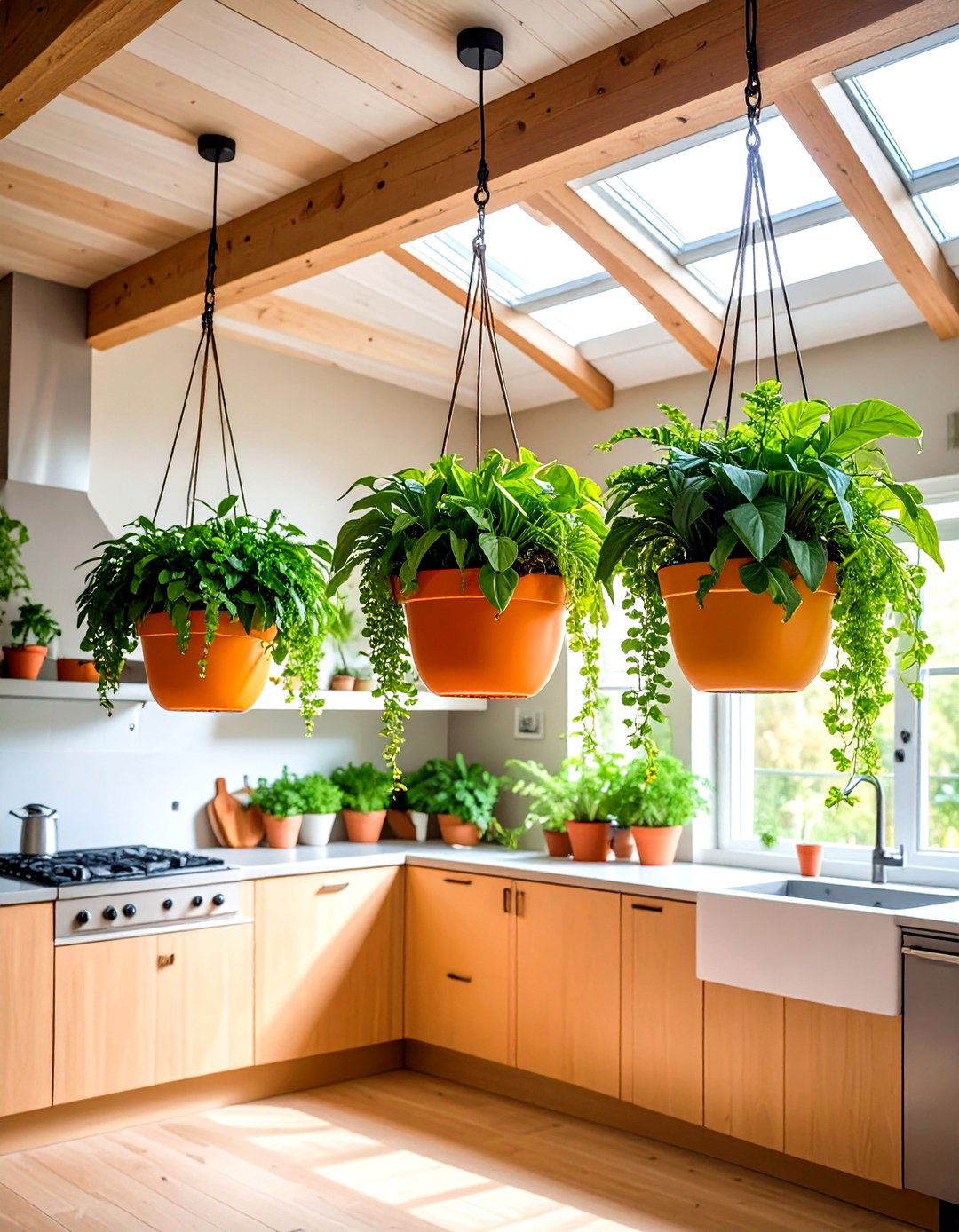
For those seeking low-impact greenery, hanging planter displays bring plant life overhead without sacrificing surface area. Suspended from robust ceiling hooks or ceiling-mounted tracks, geometric or macramé planters hold trailing pothos, ferns, or aromatic herbs, creating a floating garden that sways gently with kitchen activity. To enhance airflow, incorporate a lightweight pulley system that allows planters to be raised for watering and trimming. Use plants with varying leaf shapes and colors for visual interest. This design transforms bare ceiling space into a lush canopy, softening acoustics and providing a soothing green atmosphere above the countertops, all while maintaining a clutter-free workspace.
4. Floor-to-Ceiling Windows for Biophilic Kitchen
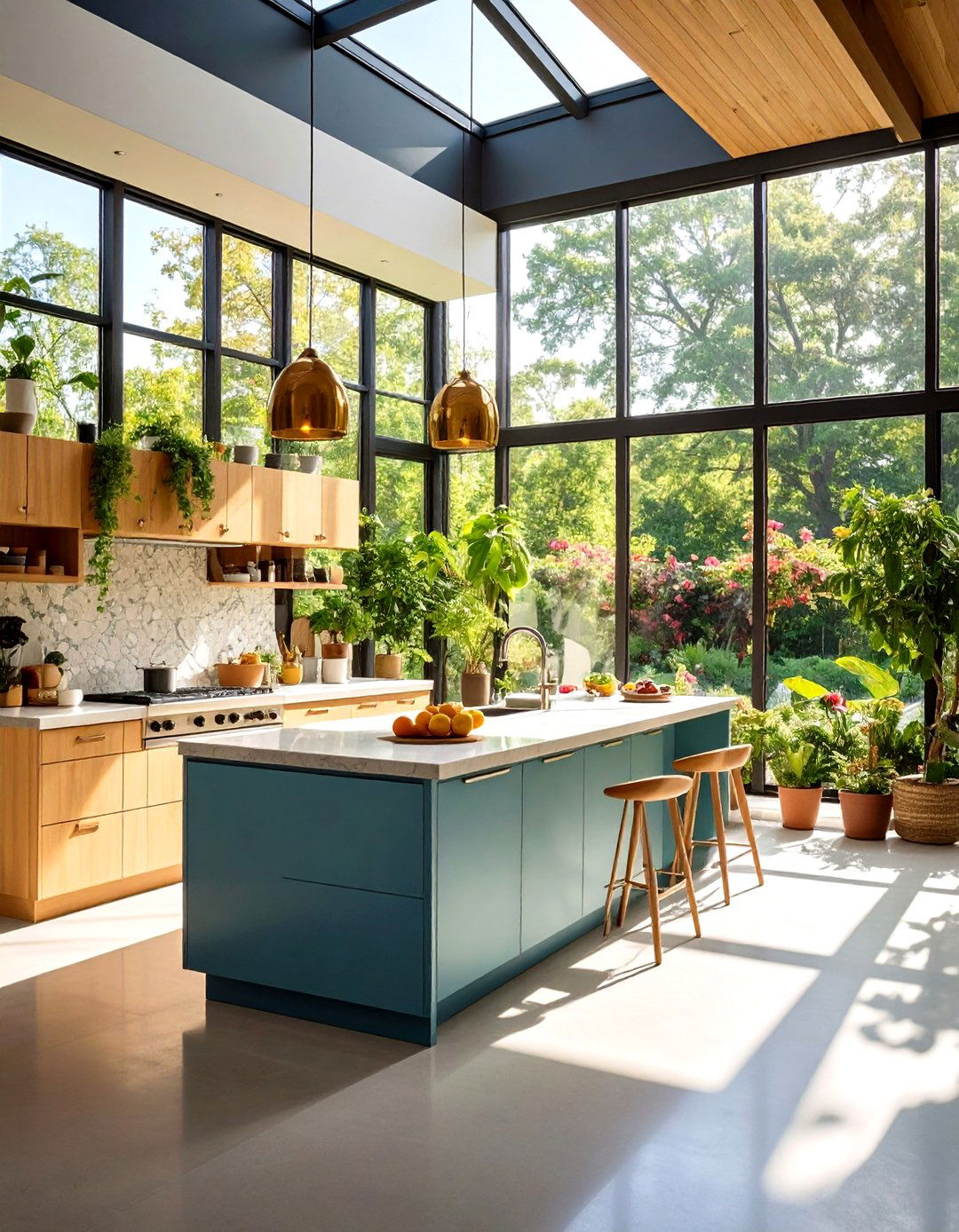
Incorporating floor-to-ceiling windows in a greenhouse kitchen can deepen your connection to nature by framing expansive garden vistas and maximizing daylight. Opt for high-performance glazing to balance heat gain and loss, ensuring comfort across seasons. Place cabinetry and appliances away from direct sun paths to prevent fading, and position countertops to catch morning light for bright, energizing meal prep. To enhance privacy without sacrificing light, install frosted or patterned panels on lower sections, while clear glass above maintains openness. Consider setting up a cozy reading corner or breakfast nook adjacent to the glazing, furnished with moisture-resistant seating, to enjoy casual meals surrounded by greenery.
5. Conservatory-Style Kitchen Extension

This concept repurposes a traditional greenhouse into a full-fledged kitchen extension that blurs indoor and outdoor living. Renovators Laura Bohn and Richard Fiore transformed a dilapidated 1960s greenhouse into an entertaining kitchen by installing floor-to-ceiling sliding glass doors that open to a terrace, and using neutral textures to unify the space. Embrace warm woods or cork tile flooring to soften the glass enclosure, and select durable countertops like Corian or stone for easy upkeep. To host gatherings year-round, integrate underfloor heating and install operable roof vents for summer ventilation. The result is a luminous, greenhouse-style kitchen that functions seamlessly for cooking, dining, and socializing.
6. Vaulted Skylight Roof for Greenhouse Kitchen

As designers highlight the importance of natural light, a vaulted skylight roof in your greenhouse kitchen becomes a dramatic yet functional focal point. Skylights or roof lanterns channel daylight into deep kitchen footprints, reducing reliance on artificial illumination and lifting spirits with sunlit warmth. Position prep areas beneath the highest vault to catch direct overhead light, and specify diffusing glazing to soften glare. To manage temperature, combine motorized skylight vents and integrated sensors that open at set thresholds. Frame the skylights with exposed timber beams for a striking contrast against glass. This approach celebrates daylight, enhances ventilation, and elevates your greenhouse kitchen with a cathedral-like sense of spaciousness.
7. Bifold Doors for Seamless Indoor-Outdoor Flow

For a seamless transition between garden and cook space, install bifold or sliding doors in your greenhouse kitchen, inviting fresh air and natural scenery inside. Choose thermally broken aluminum frames to minimize heat transfer while preserving slim sightlines. When opened, these doors fold neatly to one side, creating an unobstructed passage that expands your kitchen for entertaining and alfresco dining. Seal gaps with weatherstripping to maintain comfort when closed, and integrate adjustable blinds or privacy screens for sun control. Position seating and prep counters near the opening to blur boundaries, letting the sights and sounds of the outdoors enrich every cooking moment.
8. Farmhouse Solarium Kitchen Greenhouse Nook
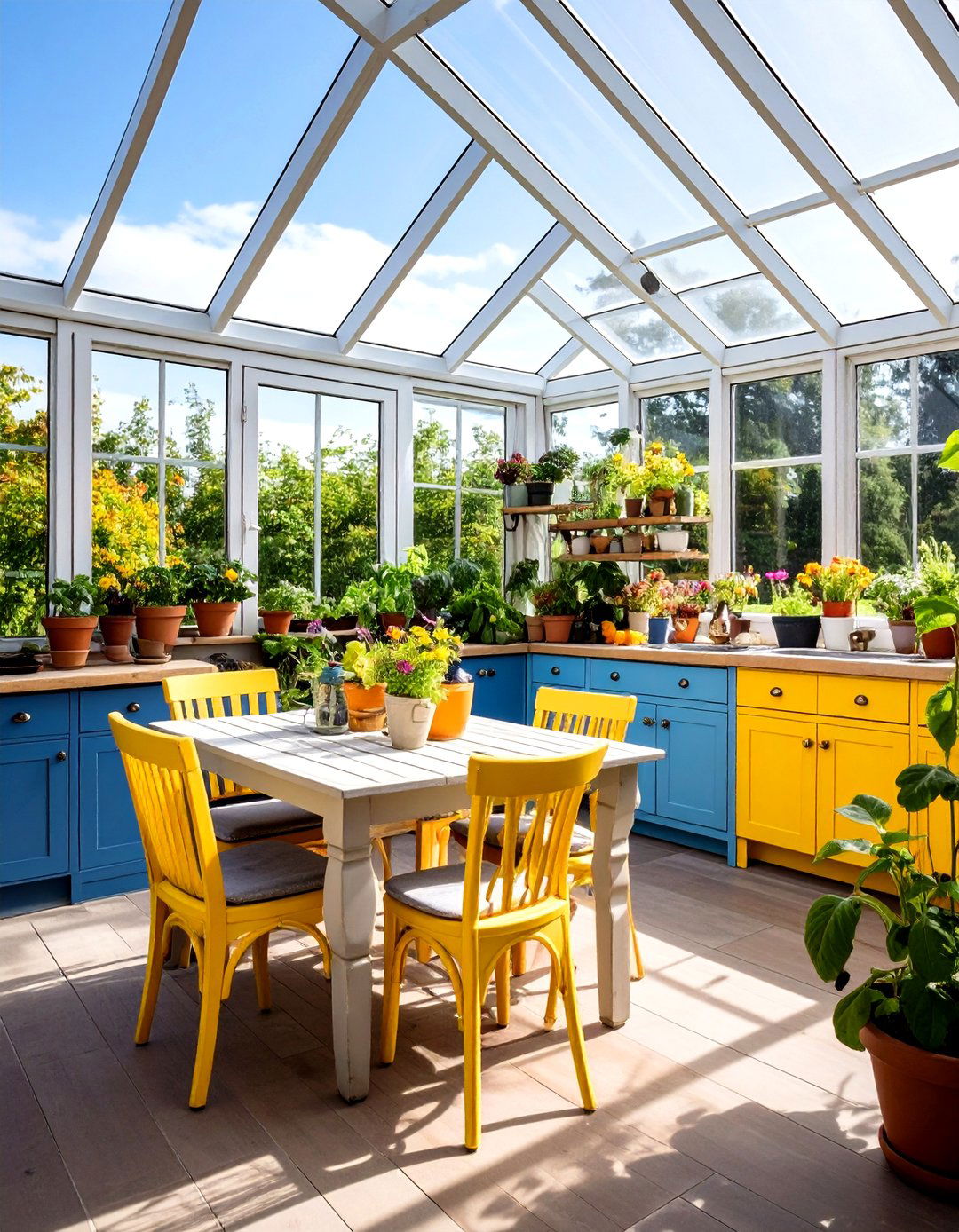
For a cozy yet functional corner, incorporate a farmhouse solarium kitchen greenhouse nook adjacent to your main cooking area. Dedicate a section for herb and vegetable cultivation—basil, tomatoes, and leafy greens—using built-in planting beds or container clusters under expansive glass panels. Position a petite bistro table and chairs within, creating a sunlit spot for breakfast or afternoon tea. Line the flooring with weather-resistant tiles or stone for durability and easy cleaning. Add retractable shades to manage sun glare, and install shelf-mounted misters to maintain humidity for heat-loving plants. This blend of rustic charm and horticultural flair enriches your greenhouse kitchen with an inviting, nature-infused alcove.
9. Integrated Scullery in Greenhouse Kitchen Layouts

To keep your main greenhouse kitchen pristine for guests, integrate a scullery—or secondary prep area—just steps away from your show kitchen. These concealed back-kitchens can house dishwashers, prep sinks, and additional countertops, streamlining cleanup and food staging. Designers suggest using contrasting colors or materials, like a bold tile or warm wood, to distinguish the scullery’s aesthetic while preserving unity. Incorporate open shelving for easy access to frequently used tools, and install a second dishwasher to accelerate post-meal tasks. Ventilate the space with a dedicated hood system to control steam and odors. An integrated scullery elevates functionality and organization in greenhouse kitchen layouts, making hosting effortless.
10. Modular Grow Stations with Pull-Out Planters
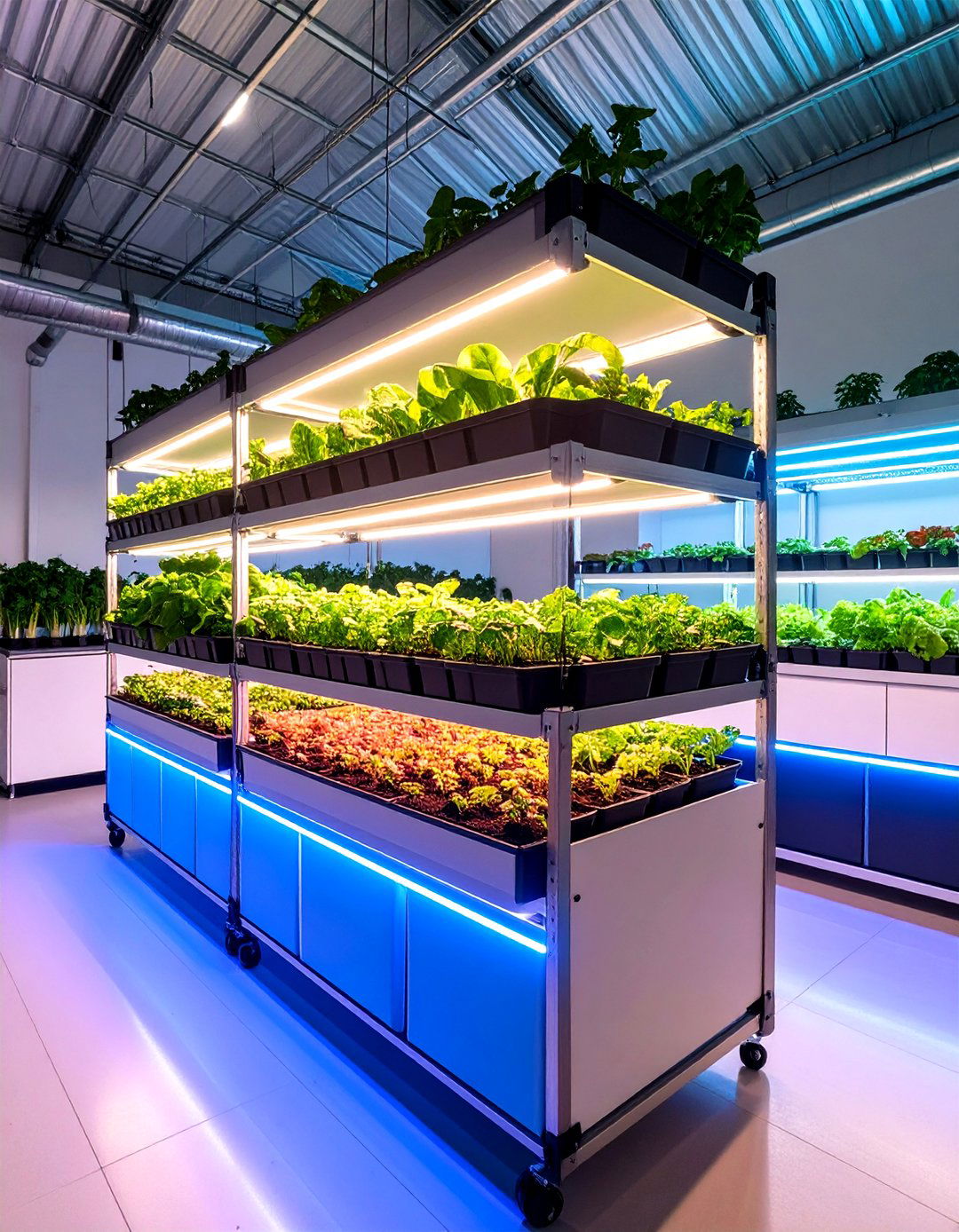
DIY enthusiasts can craft modular grow stations with pull-out planters for a customizable greenhouse kitchen feature. By following simple PVC pipe assembly instructions, you can build tiered modular frames that slide in and out like drawers, granting easy access to microgreens and herbs. Nest planter trays on waterproof liners and install LED grow bars beneath each shelf to ensure uniform light exposure. For a refined look, encase the frame in cabinetry matching your kitchen finish. Include a self-watering reservoir and overflow protection to automate hydration. These adaptable stations let you rotate crops seasonally and scale your indoor garden according to your culinary adventures.
11. Passive Solar Thermal Mass in Greenhouse Kitchens
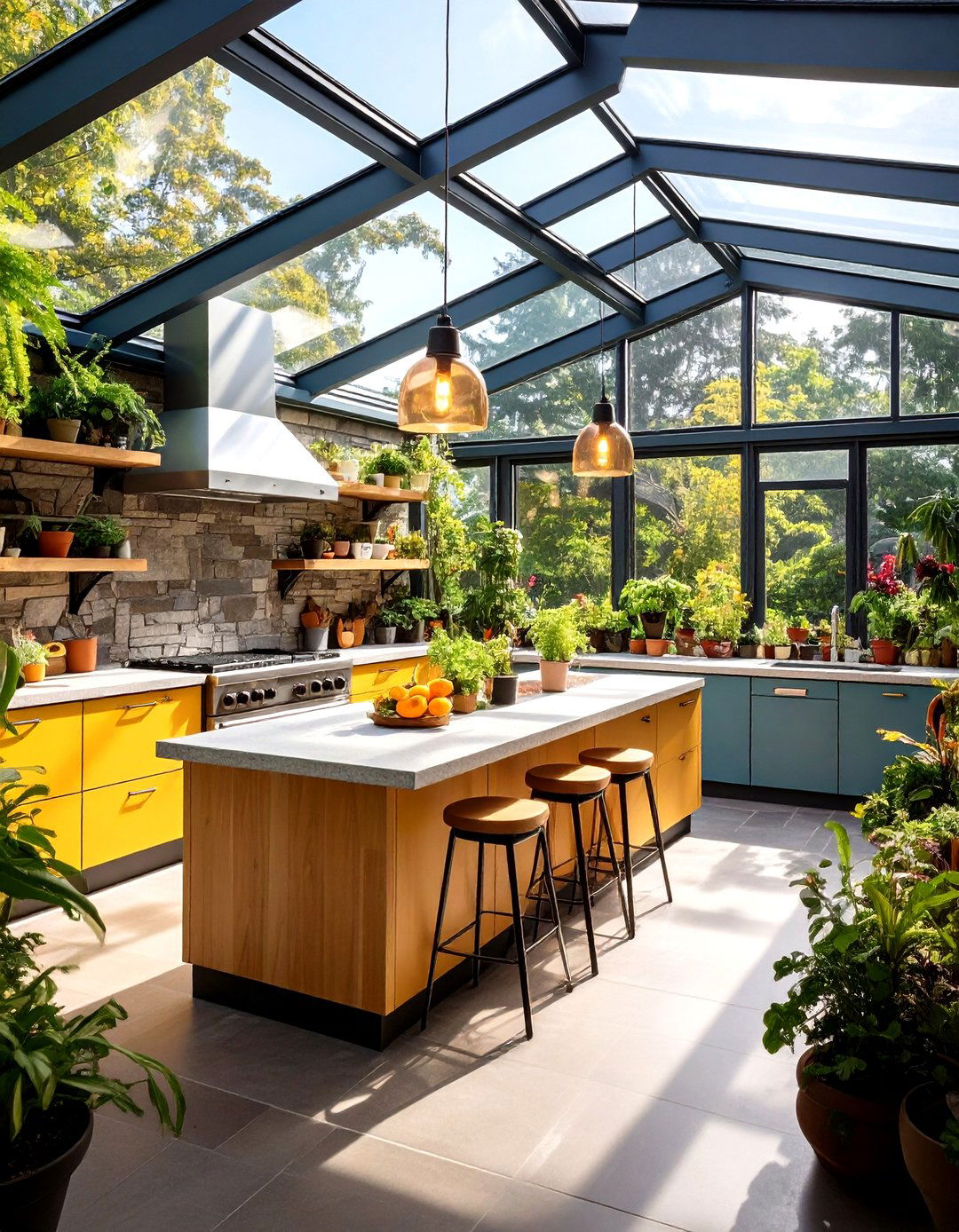
Passive solar principles can regulate temperature swings in a greenhouse kitchen by integrating thermal mass elements. Heavy materials like brick walls, stone countertops, or water-filled thermal storage tanks absorb solar heat through south-facing glazing and release warmth when temperatures drop. Position stone-topped islands or masonry-lined bench seats where sunlight hits directly. To extend heat retention, install insulated shutters or movable panels over glazing at night. Incorporating a roof pond system—water containers placed on or within the ceiling—further boosts storage capacity and moderates indoor climate. Embracing these passive strategies minimizes energy costs and maintains a stable, comfortable cooking environment.
12. Eco-Friendly Reclaimed Materials for Kitchen Greenhouses
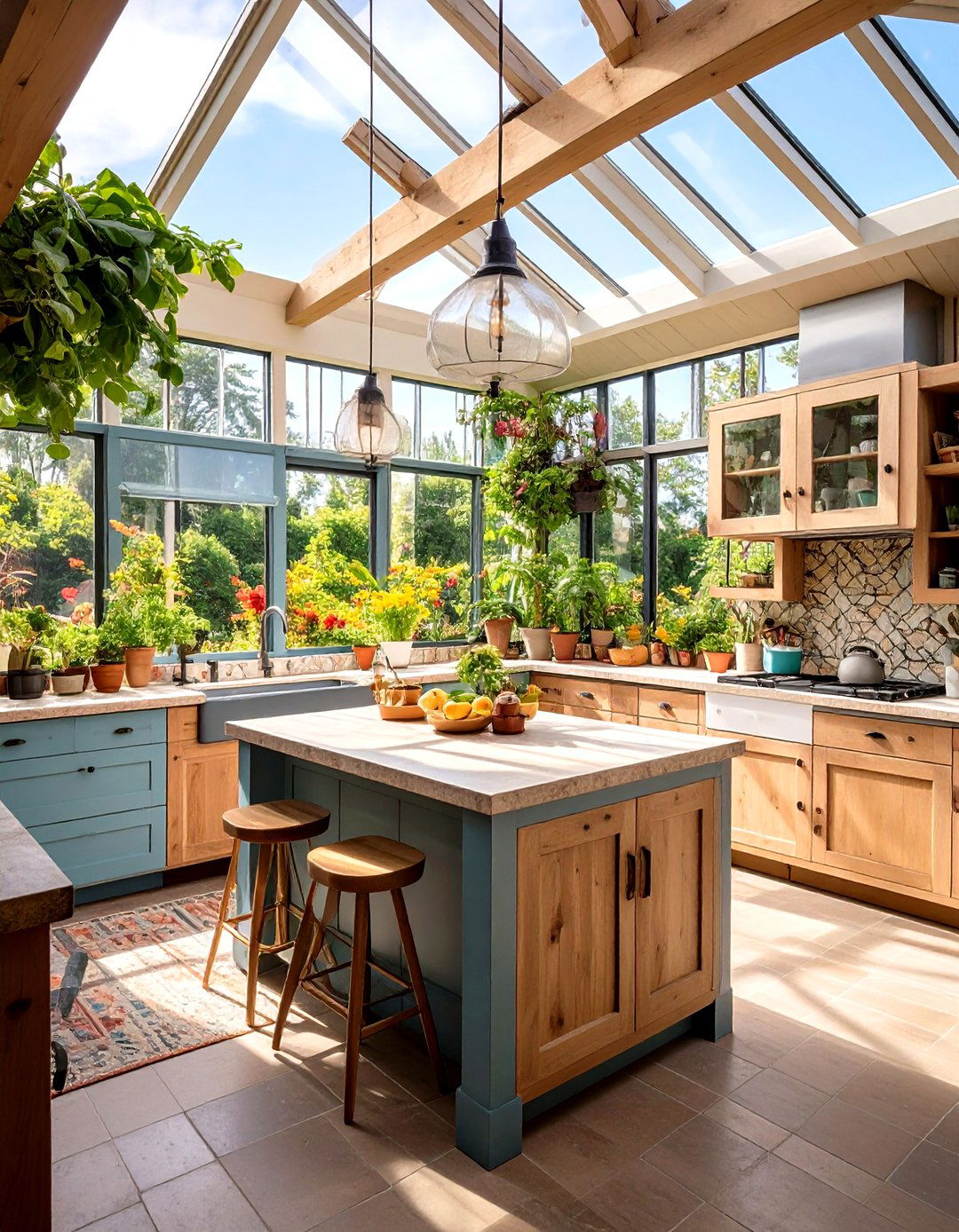
Prioritizing reclaimed or recycled materials in a greenhouse kitchen reinforces sustainability and aged patina. Designers champion surfaces like reclaimed wood cabinetry, salvaged brick backsplashes, and recycled stone countertops for their environmental benefits and enduring character. Combine these with matte black or powder-coated metal accents to anchor the rustic elements. For flooring, consider recycled terracotta tiles or cork for resilience and warmth underfoot. Sealing reclaimed surfaces with eco-friendly varnishes protects against moisture without harmful off-gassing. By weaving second-life materials into your greenhouse kitchen, you not only reduce your carbon footprint but also infuse the space with unique stories and textures that evolve gracefully over time.
13. Polytunnel-Inspired Arched Ceiling Kitchen

Drawing inspiration from polytunnel design, an arched ceiling in your greenhouse kitchen not only maximizes overhead space but also creates a sense of airy openness. The gentle curvature of hoophouse structures evenly disperses sunlight, warming the room naturally. To adapt this concept indoors, use curved steel ribs clad in translucent polycarbonate, offering durability and diffused light. Integrate adjustable vent panels along the arch’s apex for efficient thermal regulation. Pair with minimalist cabinetry and floating shelves to accentuate the arch without crowding the volume. This polytunnel-inspired approach melds agricultural efficiency with contemporary style, forging a kitchen that feels both spacious and plant-friendly.
14. Victorian-Style Glass Accents for Greenhouse Kitchens
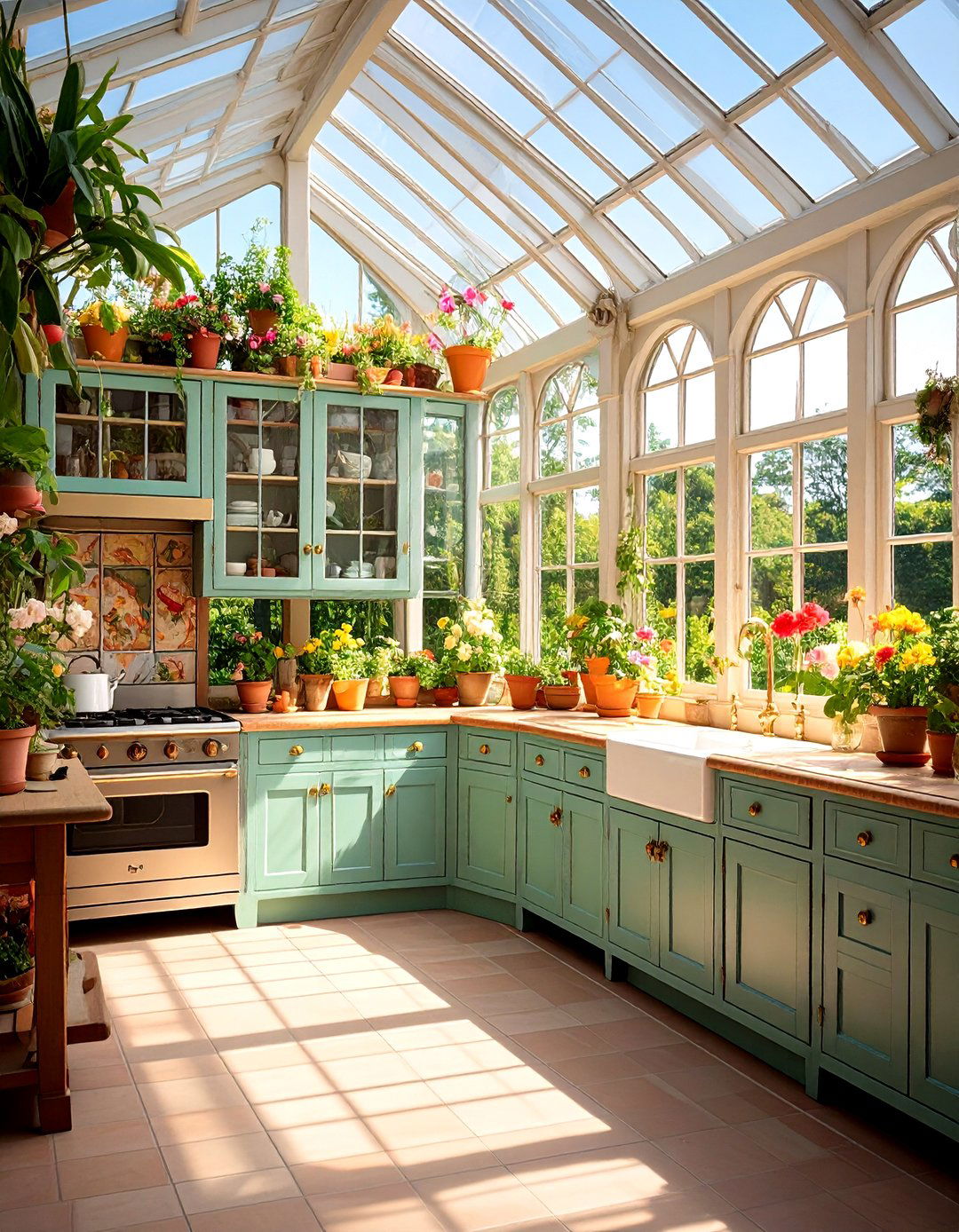
Victorian-era charm seamlessly blends with modern kitchens by incorporating botanical glass-front cabinets, decorative crown molding, and arched window frames inspired by classic conservatories. This style features translucent cabinetry doors etched with delicate botanical motifs, inviting soft light to illuminate dishware and cookbooks. Emphasize symmetry in cabinet layouts, and select hardware with period-appropriate finishes like antiqued brass or iron. Pair the glass accents with marble or soapstone countertops for an elegant contrast. To complete the look, install stained-glass transom windows above interior doorways, filtering colored light into adjacent rooms. These Victorian-style glass details lend historical depth and artisanal flair to any greenhouse kitchen.
15. Smart Hydroponic Shelving for Kitchen Greenhouses
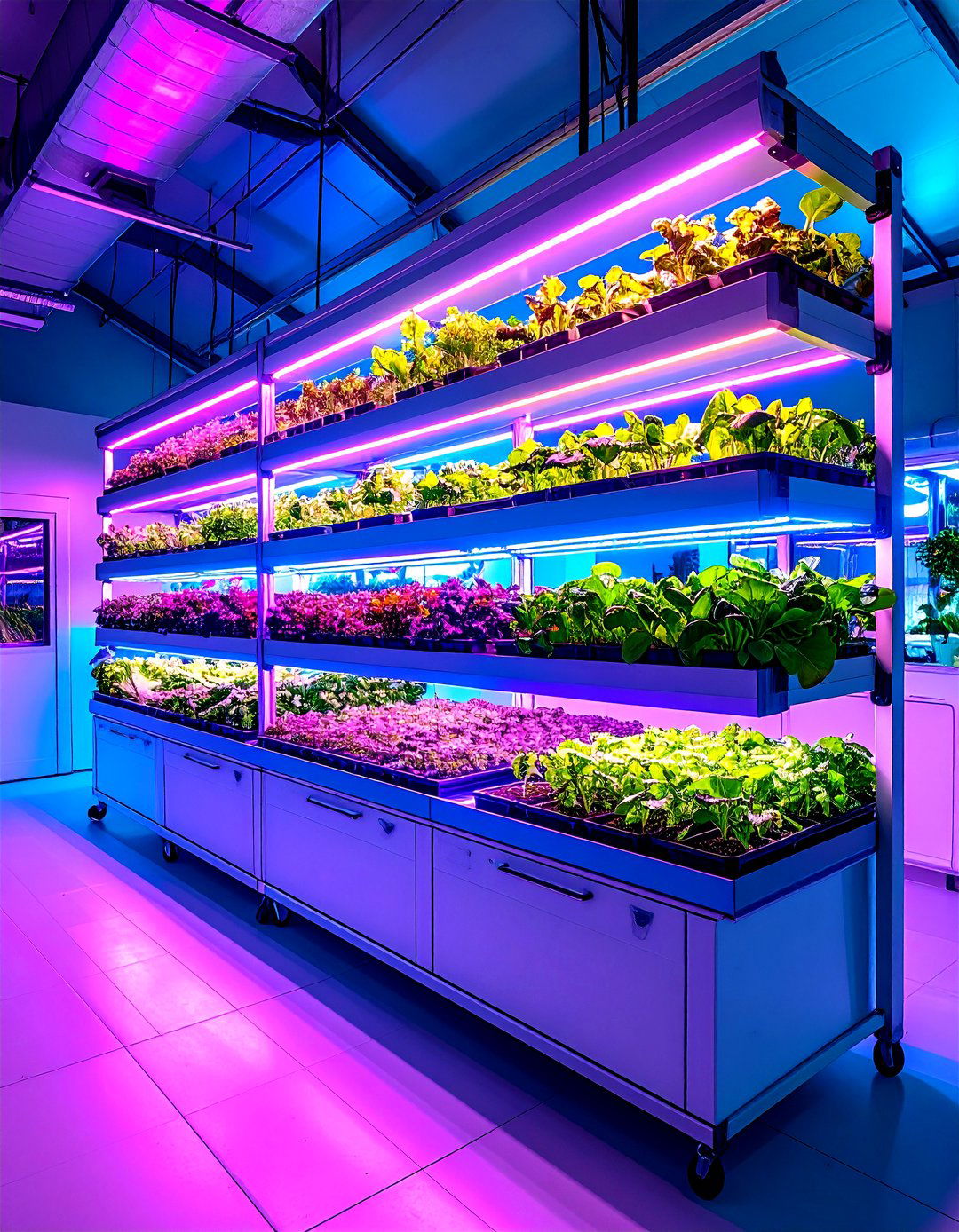
Elevate your greenhouse kitchen with smart hydroponic shelving systems that automate watering and lighting, delivering fresh produce at your fingertips. Select modular units such as AeroGarden Harvest or Rise Gardens racks, which feature self-watering reservoirs, LED grow lights, and companion apps to monitor pH and nutrient levels. Position the system near an electrical outlet and ensure stable support on moisture-resistant flooring. Rotate herb varieties and leafy greens every cycle to keep produce varied and interesting. The sleek, vertical design conserves floor space and complements contemporary cabinetry. By harnessing smart hydroponics, you’ll enjoy year-round harvests and reduce reliance on store-bought greens, all within a stylish greenhouse kitchen setting.
16. Retractable Roof Panels for Ventilation Control

To manage heat buildup in a greenhouse kitchen, install retractable roof panels or adjustable louvers that open automatically based on temperature thresholds. These solar-responsive systems can integrate thermal sensors that trigger motorized panels, optimizing airflow and preventing overheating on sunny days. For manual control, choose lightweight aluminum frames with easy-glide tracks. Pair the roof vents with sidewall vents or ceiling fans to create cross circulation and disperse stale air. Weatherproof seals and automated rain sensors ensure panels close during storms, protecting the interior. Consider matching panel finishes to your kitchen trim for a cohesive aesthetic. This dynamic ventilation strategy maintains a comfortable cooking environment while preserving the greenhouse look.
17. Integrated Composter and Herb Wheel in Kitchen
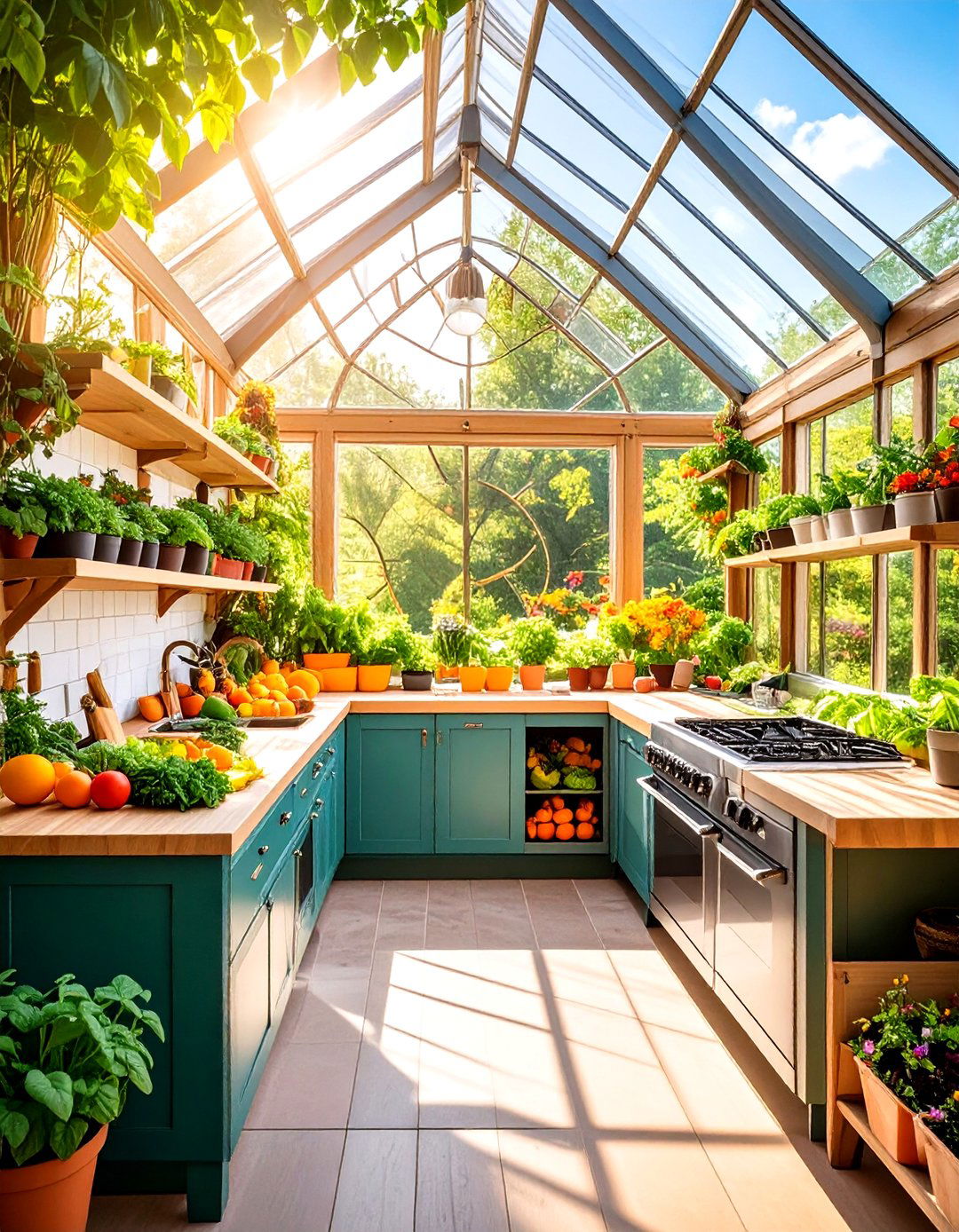
Innovate your greenhouse kitchen by integrating a built-in composter beneath the sink or in a lower cabinet, turning kitchen scraps into nutrient-rich soil for your indoor garden. Pair this with a countertop herb wheel—a rotating circular planter stocked with herbs like basil, rosemary, and chives—that spins into view when needed. These features close the loop on food waste and fresh flavors, simplifying gardening chores. Ensure proper ventilation for the composter with a charcoal filter to control odors. The herb wheel’s self-watering reservoir manages moisture levels, making it a low-maintenance statement piece that enhances both sustainability and convenience. Enhanced with a built-in LED light ring for nighttime use, it serves as both a functional element and a modern focal point.
18. Botanical Accent Lighting in a Greenhouse Kitchen
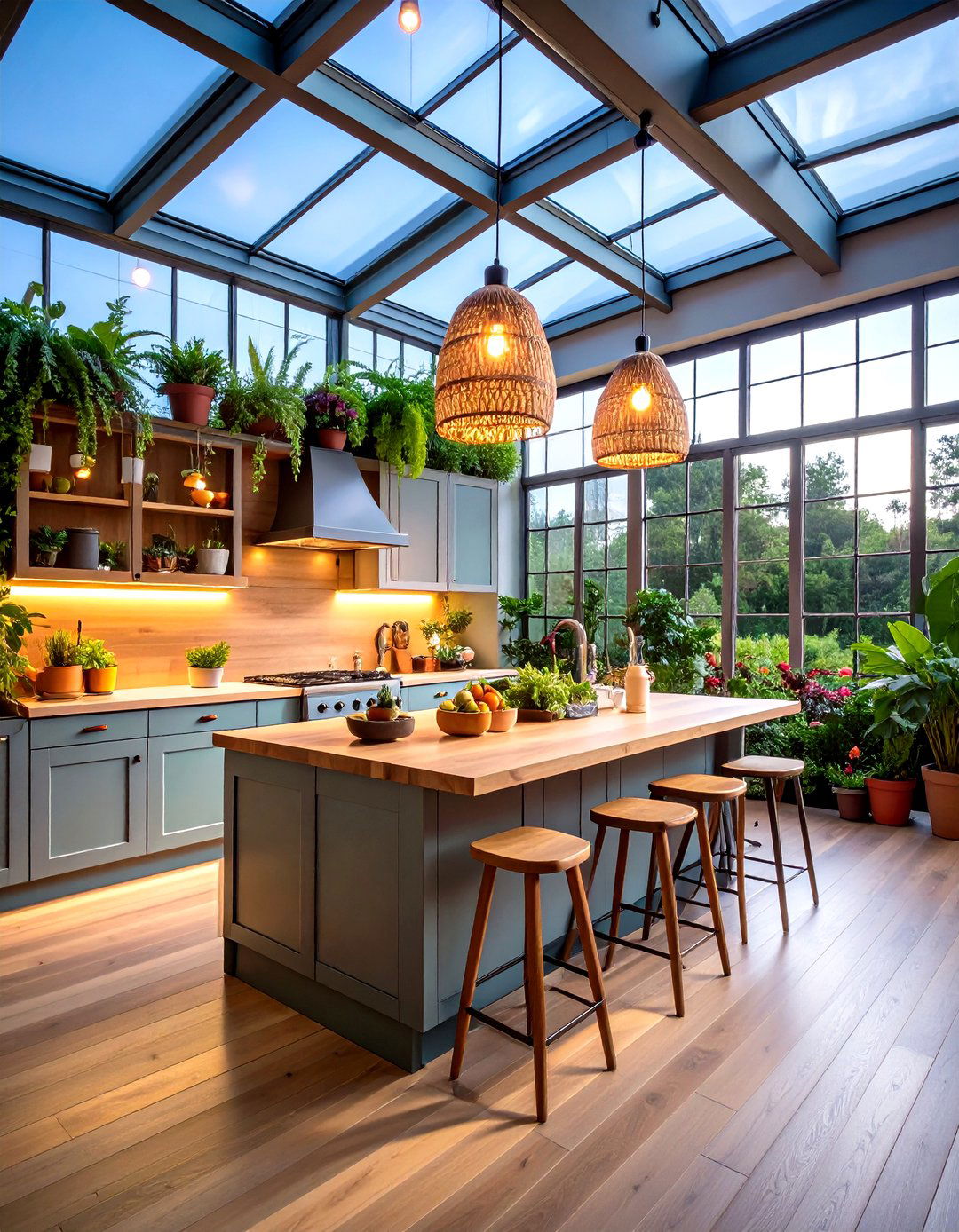
Botanical accent lighting marries form and function in greenhouse kitchens by spotlighting plants and work zones. Use adjustable track heads fitted with full-spectrum LED bulbs to highlight potted ferns or hanging planters, creating dynamic shadows and depth. Incorporate under-cabinet strip lights with warm color temperatures along green-tiled backsplashes to accentuate foliage. For a sculptural touch, install pendant fixtures woven from rattan or natural fibers above islands, blending seamlessly with plant textures. Integrate dimmable controls and zoned circuits to tailor brightness to tasks or mood. This layered lighting approach ensures both optimal plant growth and a cozy, inviting greenhouse kitchen atmosphere.
19. Foodscaping Edible Landscaping in Kitchen Greenhouses
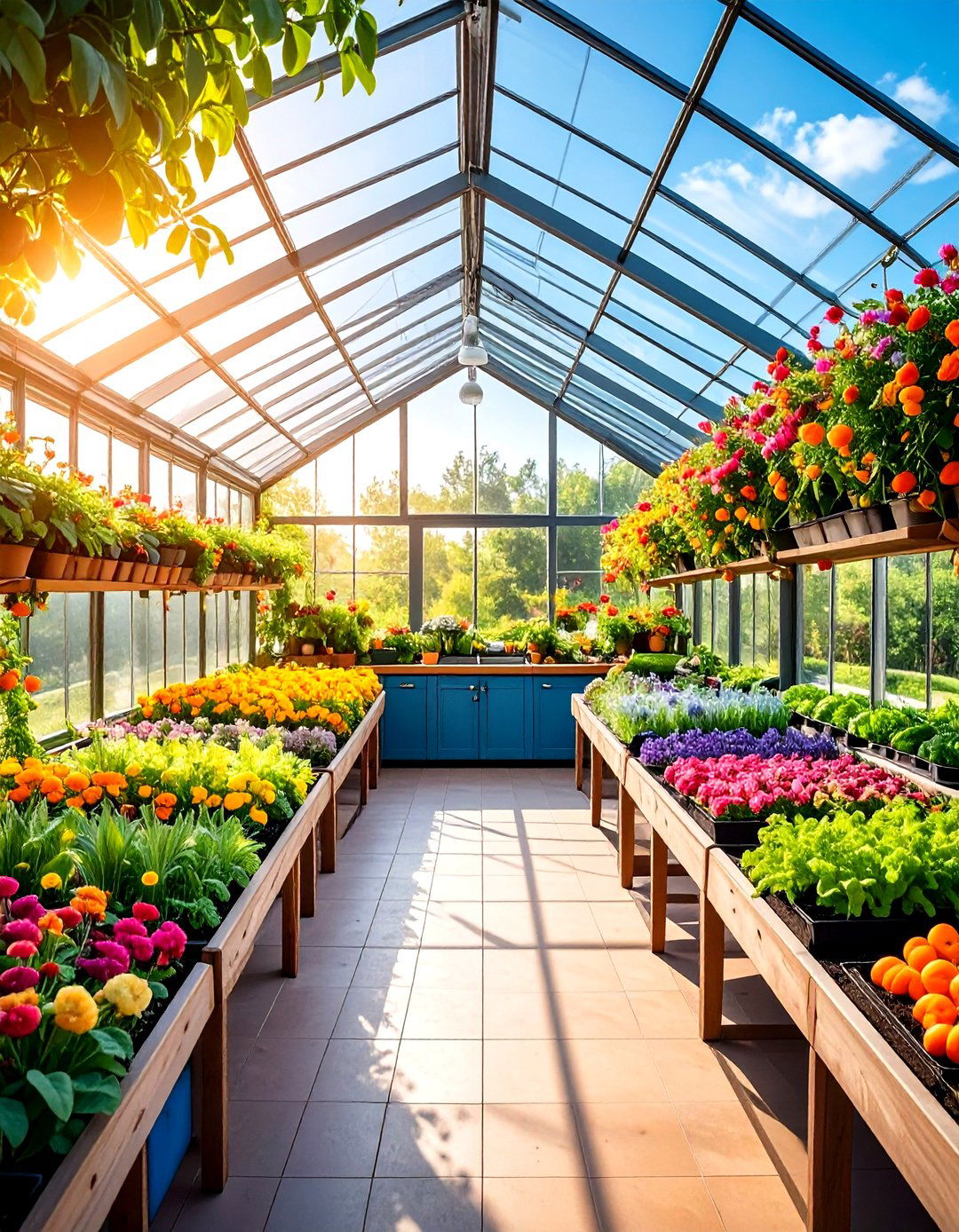
Embrace foodscaping by integrating edible plants as decorative elements in your greenhouse kitchen. Ornamental yet functional vegetables like Swiss chard, colorful lettuce mixes, and edible flowers can thrive in raised beds or container pairings. Incorporate dwarf fruit trees or berry shrubs in corner planters to provide pops of color and seasonal harvests. Use formal knot-garden patterns with low-growing herbs to craft living floor mosaics. Select companion plants that deter pests, such as marigolds alongside tomato vines. This blend of aesthetics and productivity transforms your kitchen greenhouse into a nourishing oasis, offering fresh ingredients at arm’s length, while doubling as vibrant interior decor.
20. Compact Urban Greenhouse Kitchen Pod
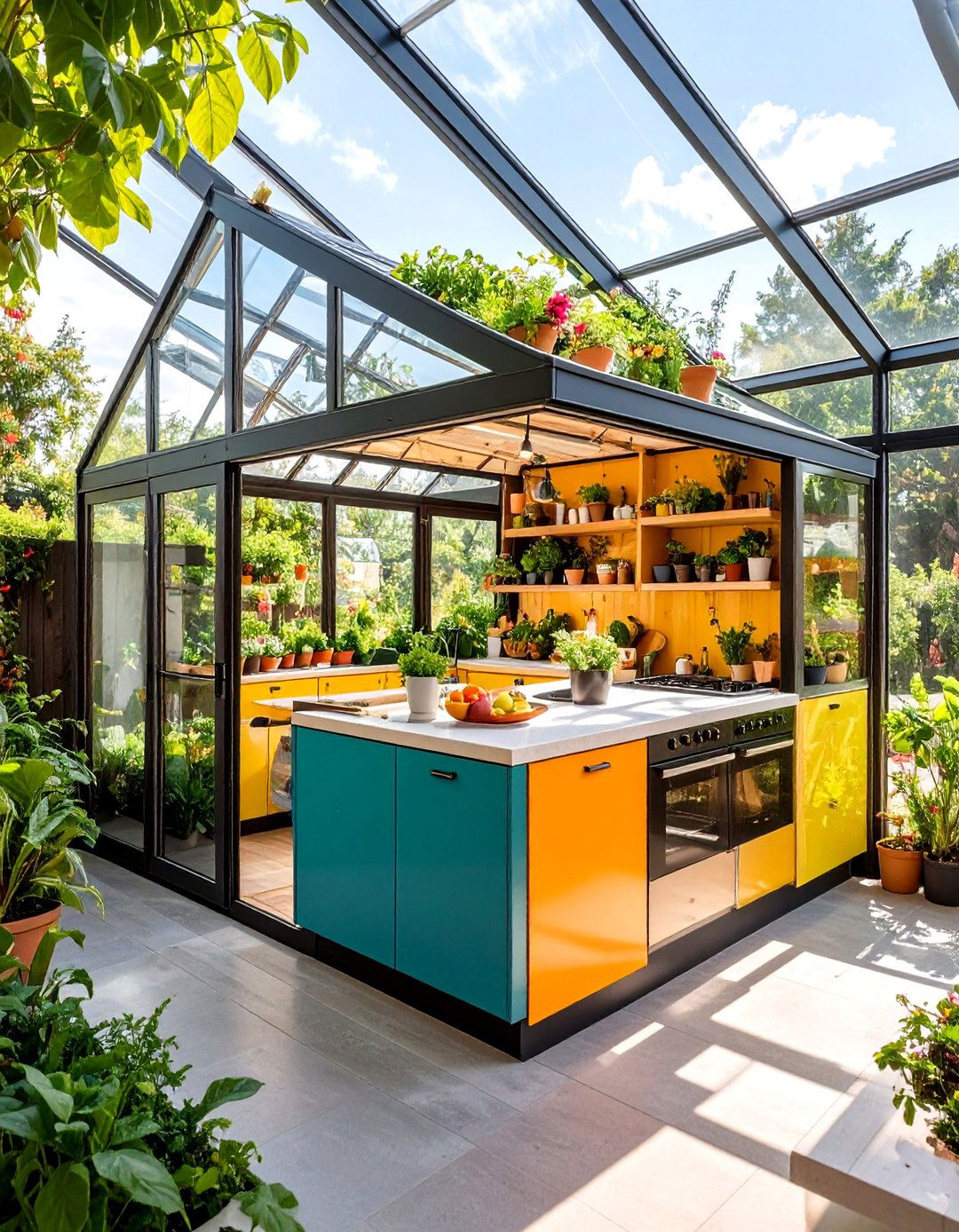
For urban dwellers, a compact greenhouse kitchen pod can merge living and cultivation in tight footprints. In Spokane, a 200-square-foot passive solar rammed-earth greenhouse ADU doubles as a kitchen and living space, harnessing solar heat and sustainable materials on a budget of $40,000. By scaling down, this pod integrates a kitchenette, dining nook, and microgreen station under a single glazed envelope. Choose space-saving multifunctional furniture—folding tables and built-in bench seating—to maximize usability. Incorporate DIY vertical planters along one wall and employ thermal curtains at night to regulate temperatures, creating a self-contained urban greenhouse kitchen haven. Install modular LED task lights and built-in appliance panels to optimize functionality in compact spaces.
Conclusion:
These twenty greenhouse kitchen design ideas demonstrate how you can blend horticulture and home cooking into harmonious, light-filled environments. From vaulted glass pavilions and vertical herb walls to passive solar elements and smart hydroponic shelves, each concept emphasizes functionality, sustainability, and aesthetic appeal. Whether you live in a sprawling property or an urban ADU, integrating biophilic features—like floor-to-ceiling glazing, retractable vents, and reclaimed materials—nurtures fresh food production and enhances well-being. Use custom sculleries, hanging planters, and Victorian accents to tailor your greenhouse kitchen to personal style. Embrace these strategies to cultivate a culinary sanctuary that feeds both body and soul.


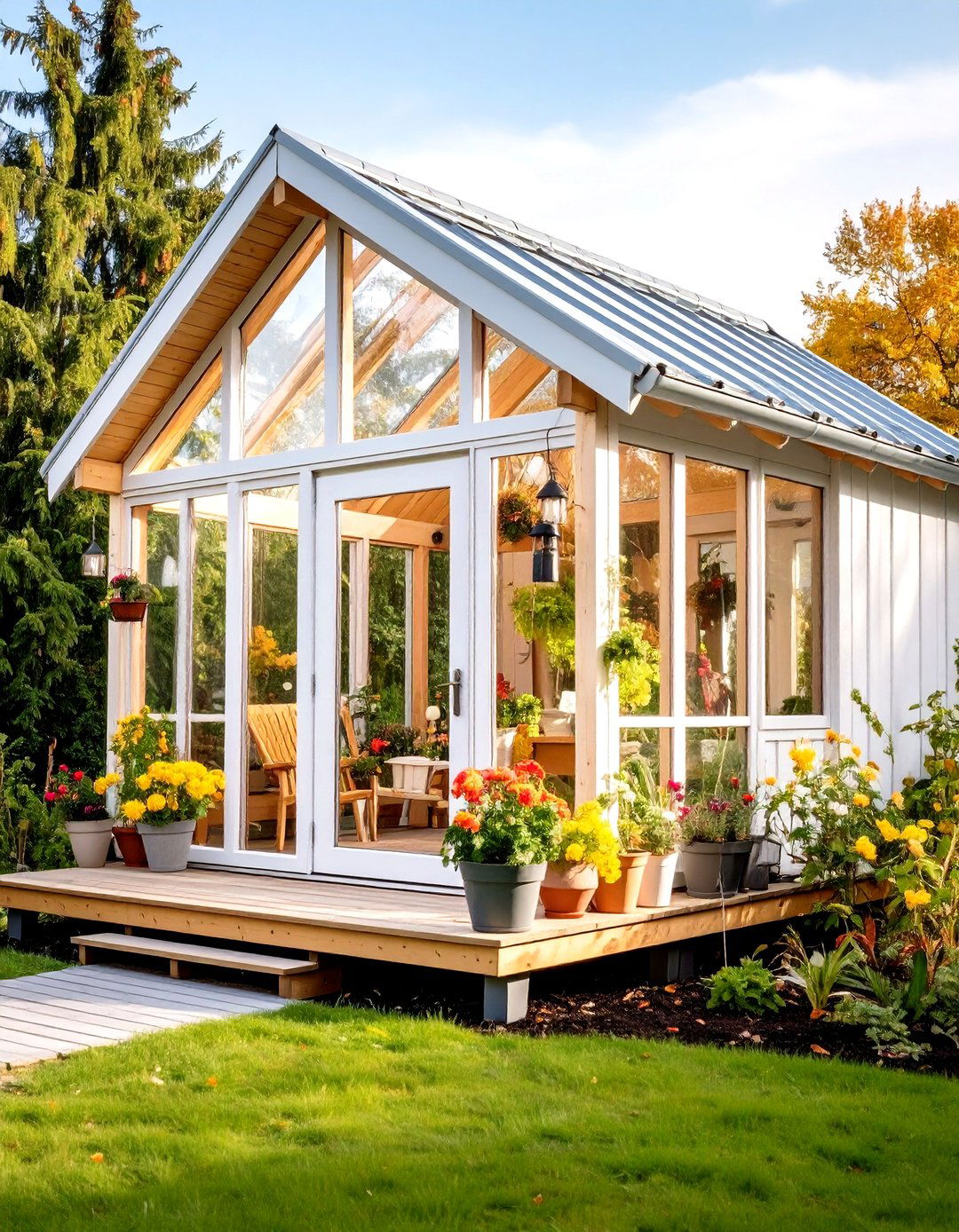
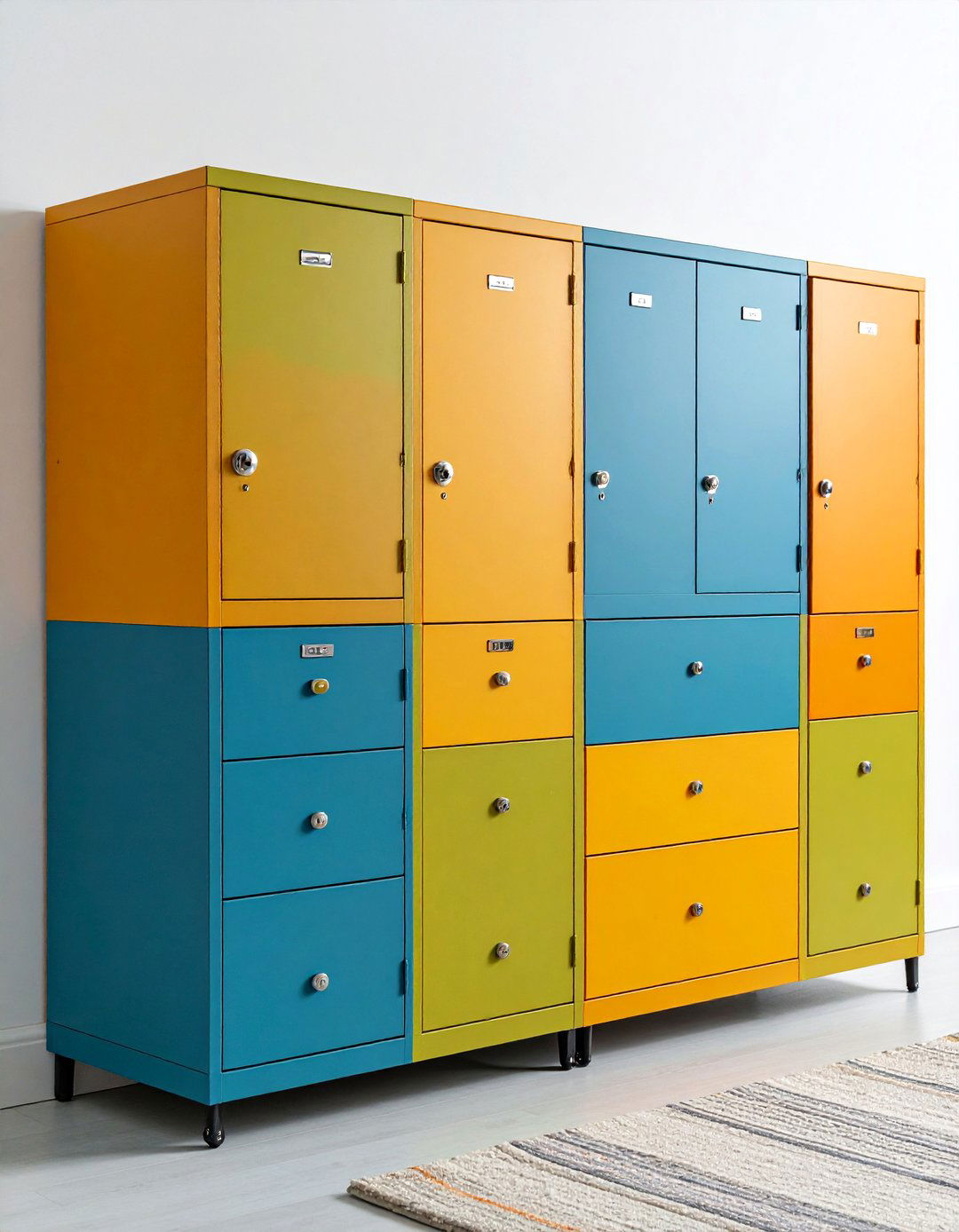


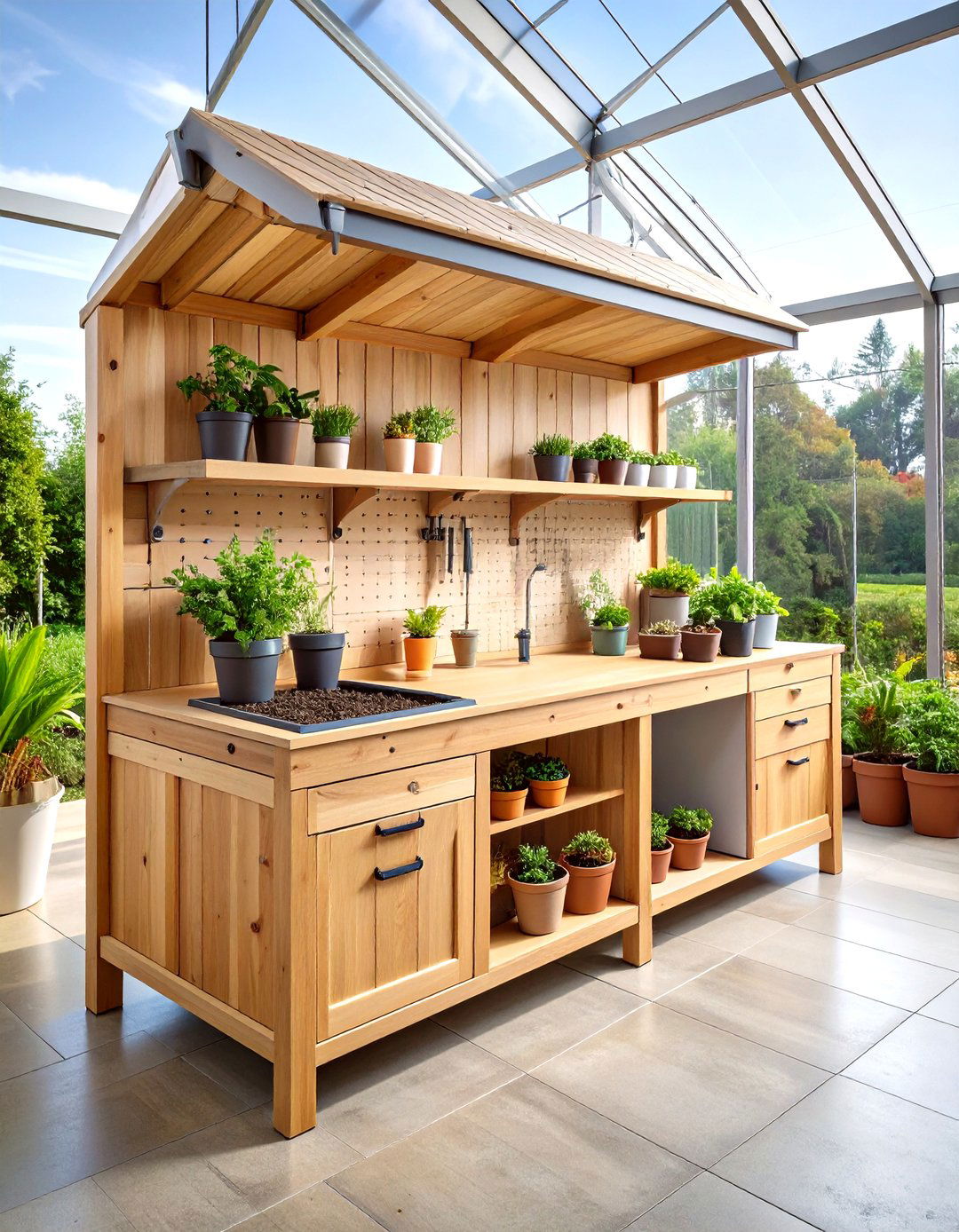

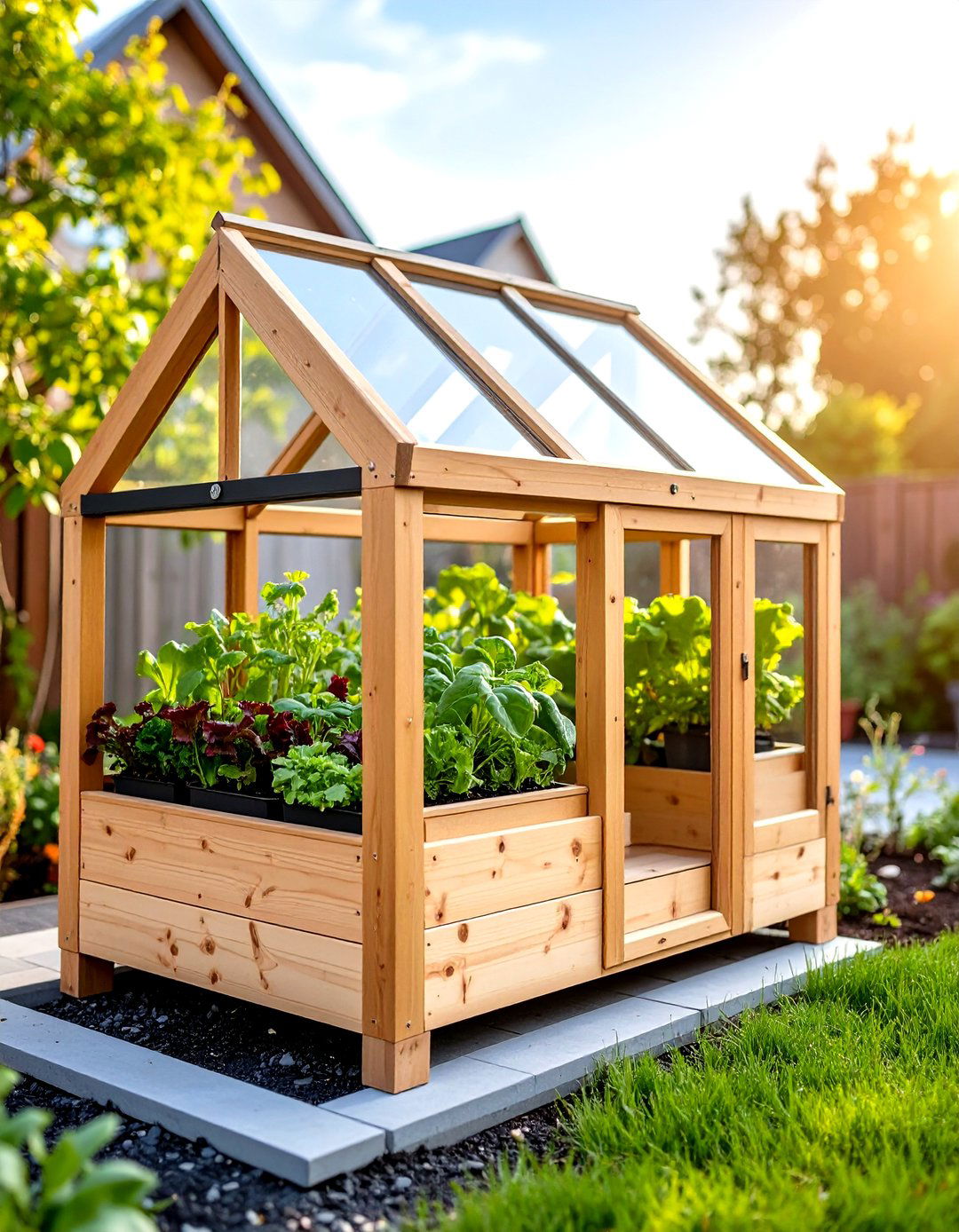
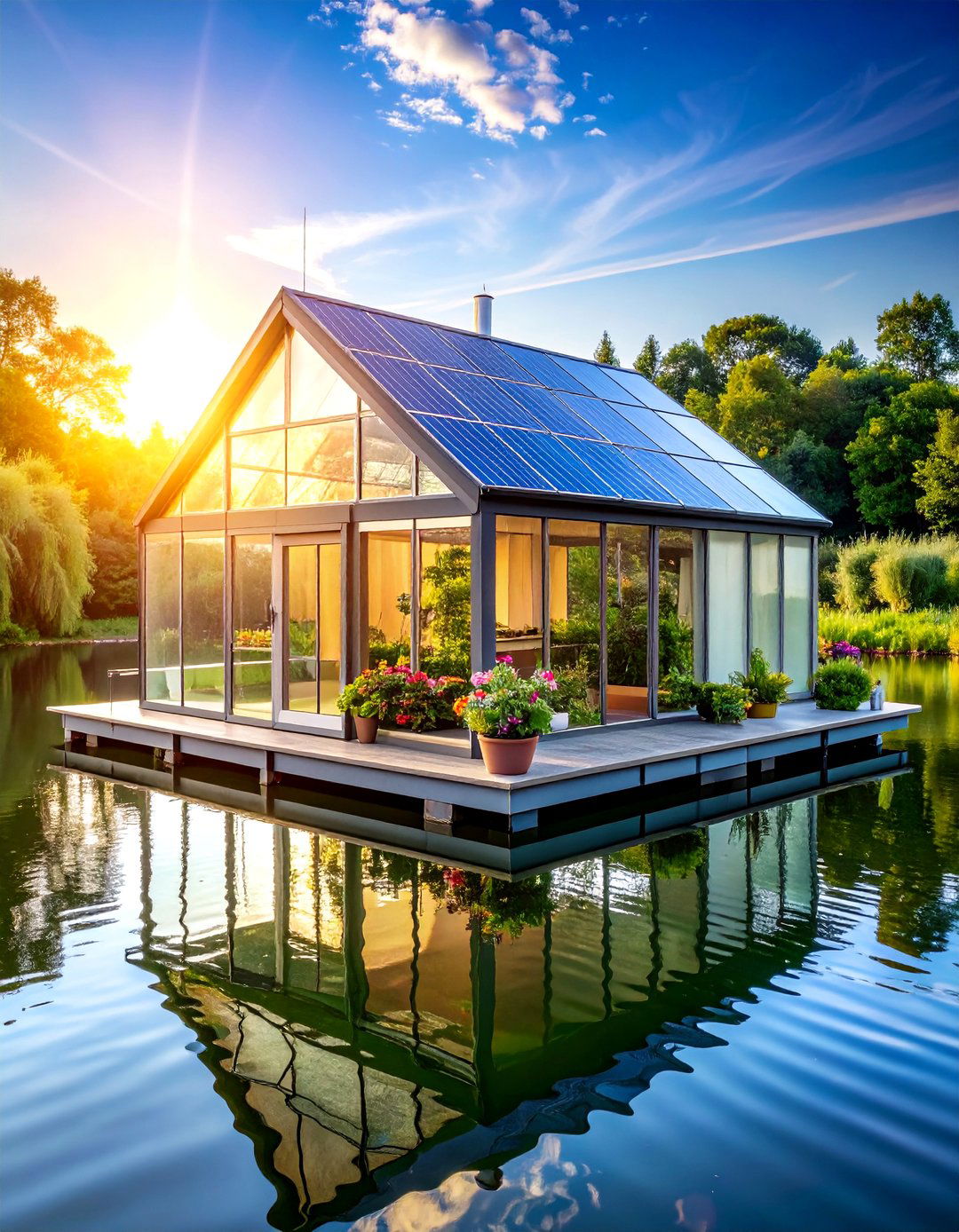
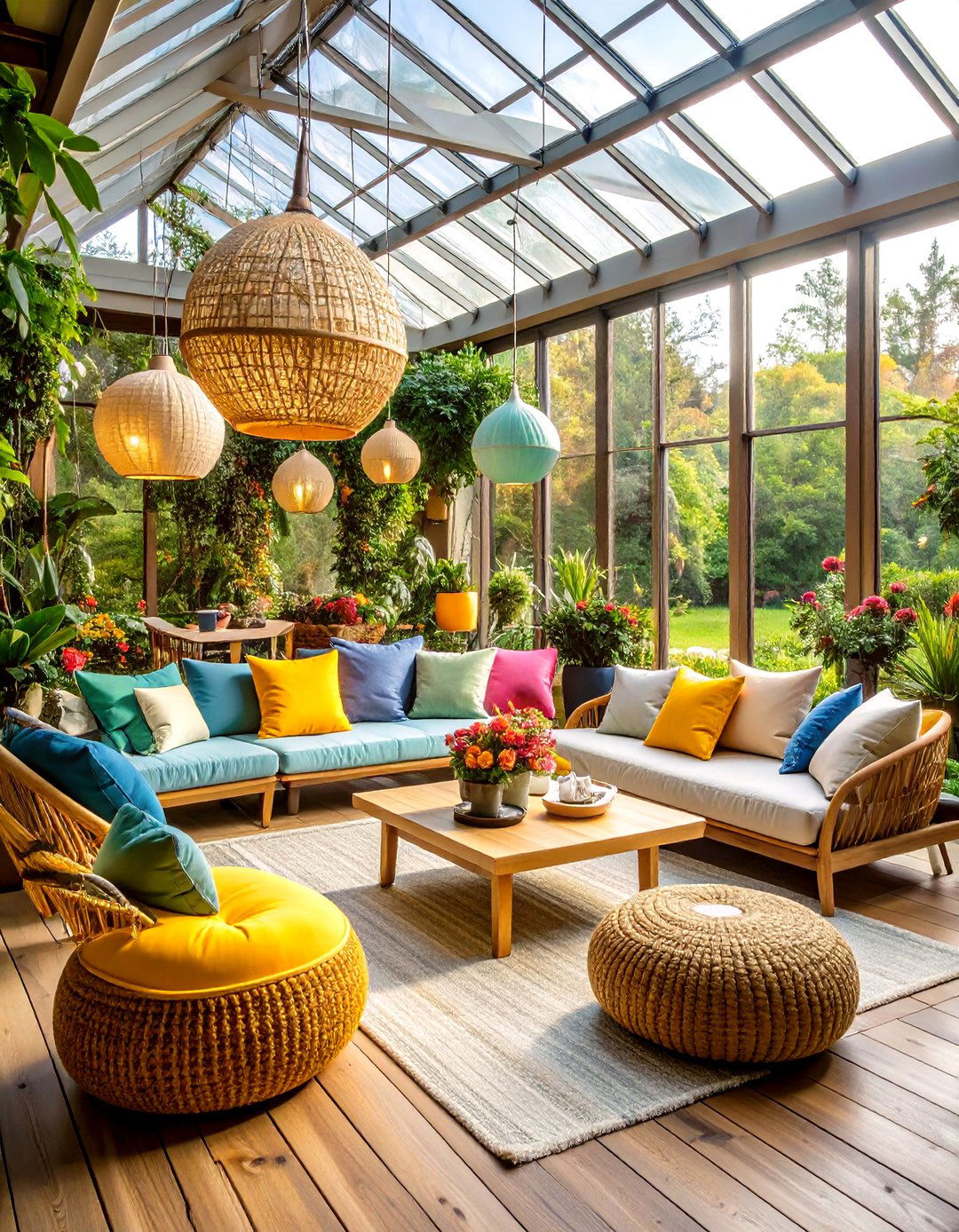

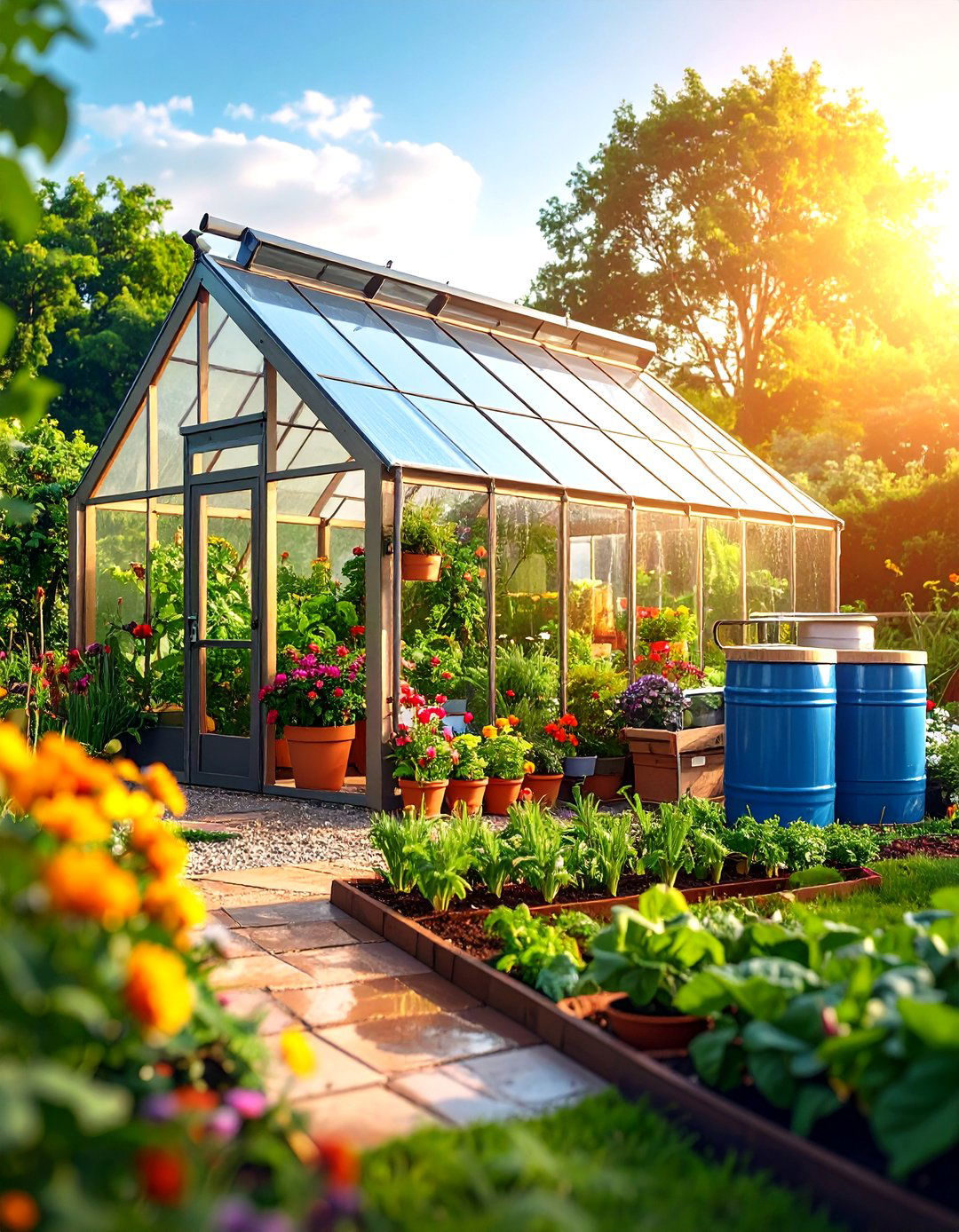
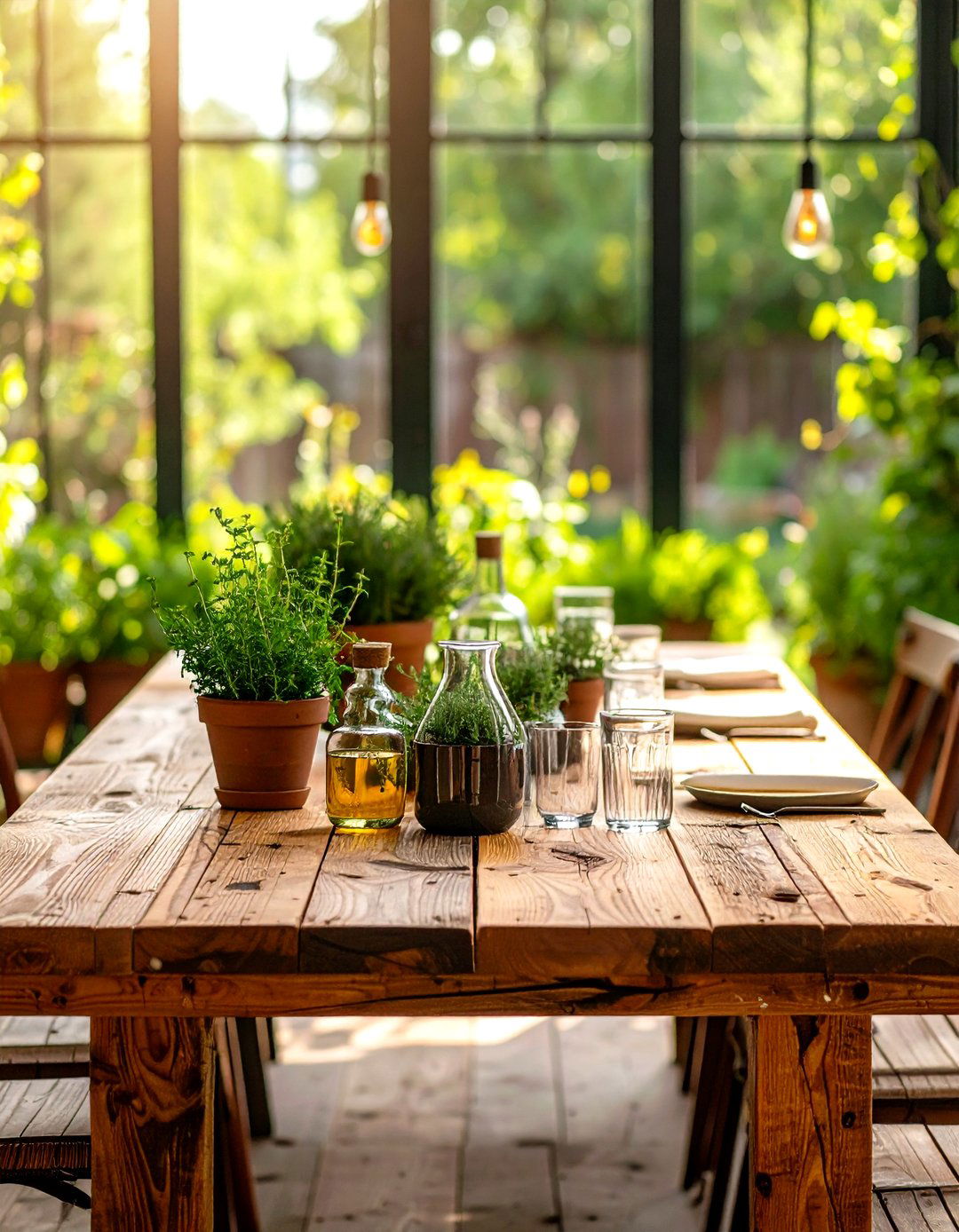
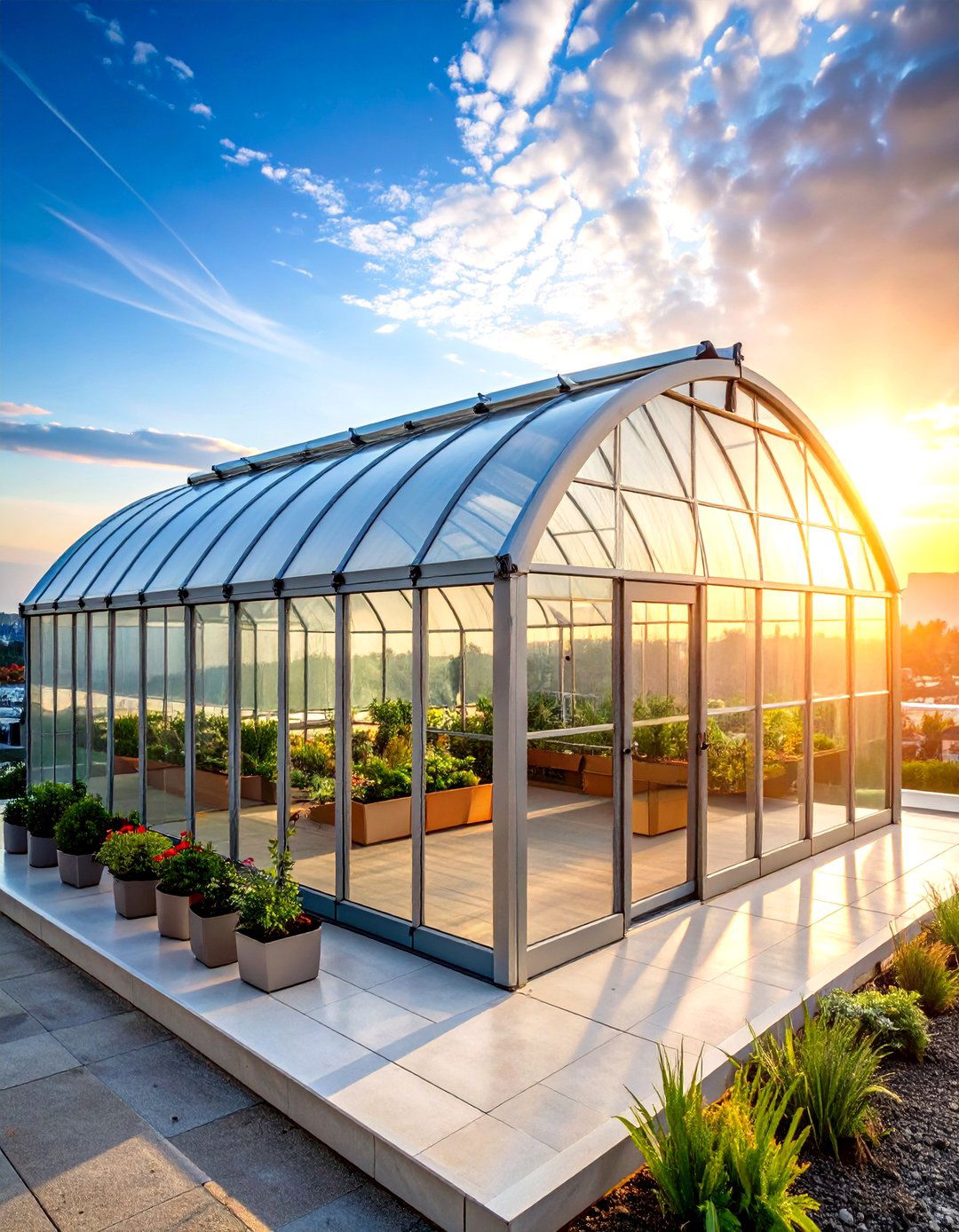

Leave a Reply